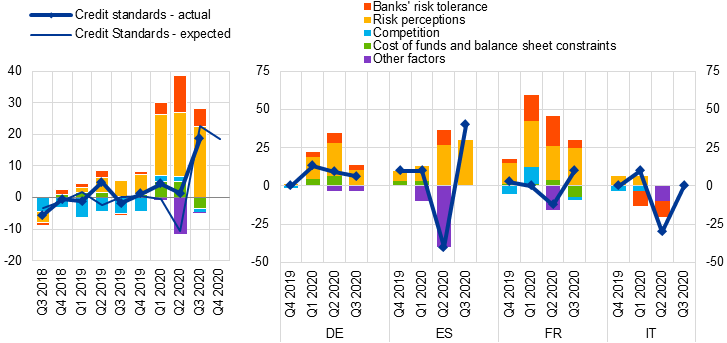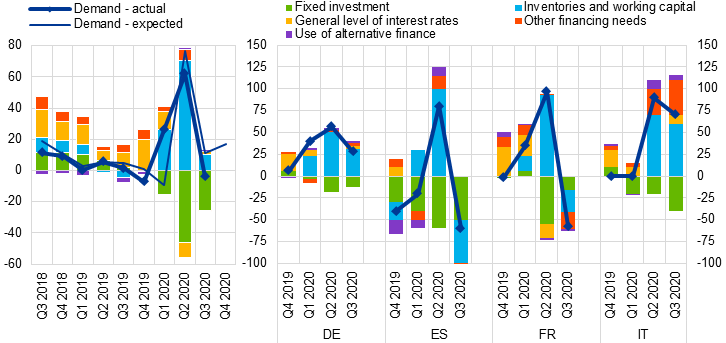- PRESS RELEASE
October 2020 euro area bank lending survey
27 October 2020
- Credit standards tightened for loans to enterprises and households
- Firms’ demand for loans moderated due to lower emergency liquidity needs
- Bank lending strongly supported by ECB measures
Credit standards – i.e. banks’ internal guidelines or loan approval criteria – tightened across all loan categories, namely loans to enterprises, loans to households for house purchase and consumer credit and other lending to households in the third quarter of 2020, according to the October 2020 bank lending survey (BLS). The net percentage of banks reporting a tightening of credit standards for loans or credit lines to firms (net percentage of banks at 19%, see Chart 1) comes after favourable developments in the previous round. Credit standards for loans to households continued to tighten (a net percentage of 20% for loans to households for house purchase and of 9% for consumer credit and other lending to households). Banks referred to the deterioration of the general economic outlook, increased credit risk of borrowers and a lower risk tolerance as relevant factors for the tightening of their credit standards for loans to firms and households.
For the fourth quarter of 2020, banks expect credit standards to continue to tighten for firms, reflecting concerns around the economic recovery as some sectors remain vulnerable, as well as uncertainties around the prolongation of fiscal support measures. The net tightening of credit standards on loans to households for house purchases is expected to continue in the fourth quarter of 2020.
Banks’ overall terms and conditions – i.e. the actual terms and conditions agreed in loan contracts –tightened in the third quarter of 2020 for new loans to enterprises, on account of wider loan margins, especially for riskier loans, and collateral requirements. For loans to households for house purchase, banks’ overall terms and conditions also tightened in the third quarter of 2020.
Firms’ demand for loans or drawing of credit lines declined in the third quarter of 2020, on account of lower emergency liquidity needs related to the coronavirus (COVID-19) pandemic following a record net increase in demand in the previous quarter (see Chart 2). The net percentage of banks reporting an increase in demand for housing loans increased in the third quarter of 2020, reflecting some catching up in demand after the lockdown period in the second quarter, and increased slightly for consumer credit and other lending to households. Net demand for housing loans and consumer credit was supported by the low general level of interest rates, while there was a significant softening in the negative contribution of consumer confidence.
In the fourth quarter of 2020, banks expect that net demand for loans to firms will rebound. Demand for housing loans is expected to fall, while demand for consumer credit is expected by banks to increase in the fourth quarter of 2020.
Regarding euro area banks’ access to retail and wholesale funding, banks reported in net terms that access improved in the third quarter of 2020. This has been supported by the ECB’s monetary policy measures. The ECB’s asset purchase programme, pandemic emergency purchase programme and the third series of targeted longer-term refinancing (TLTRO III) operations have had a positive impact on banks’ liquidity positions and market financing conditions. In combination with the negative deposit facility rate, these measures have had an easing impact on bank lending conditions and a positive impact on lending volumes. In particular, the TLTRO III operations have strongly supported bank lending over the past six months. At the same time, the ECB’s asset purchases and the negative deposit facility rate are assessed by banks as having a negative impact on their profitability through a negative impact on their net interest income, with this being somewhat mitigated by the ECB’s two-tier system for remunerating excess liquidity holdings.
The euro area bank lending survey, which is conducted four times a year, was developed by the Eurosystem in order to improve its understanding of banks’ lending behaviour in the euro area. The results reported in the October 2020 survey relate to changes observed in the third quarter of 2020 and expected changes in the fourth quarter of 2020, unless otherwise indicated. The October 2020 survey round was conducted between 21 September and 6 October 2020. A total of 143 banks were surveyed in this round, with a response rate of 100%.
For media queries, please contact Silvia Margiocco tel.: +49 69 1344 6619.
Notes
- A report on this survey round is available at https://www.ecb.europa.eu/stats/ecb_surveys/bank_lending_survey/html/index.en.html. A copy of the questionnaire, a glossary of BLS terms and a BLS user guide with information on the BLS series keys can also be found on that web page.
- The euro area and national data series are available on the ECB’s website via the Statistical Data Warehouse (http://sdw.ecb.europa.eu/browse.do?node=9691151). National results, as published by the respective national central banks, can be obtained via https://www.ecb.europa.eu/stats/ecb_surveys/bank_lending_survey/html/index.en.html.
- For more detailed information on the bank lending survey, see Köhler-Ulbrich, P., Hempell, H. and Scopel, S., “The euro area bank lending survey”, Occasional Paper Series, No 179, ECB, 2016 (http://www.ecb.europa.eu/pub/pdf/scpops/ecbop179.en.pdf).
Chart 1
Changes in credit standards for loans or credit lines to enterprises and contributing factors
(net percentages of banks reporting a tightening of credit standards and contributing factors)

Source: ECB (BLS).
Notes: Net percentages are defined as the difference between the sum of the percentages of banks responding “tightened considerably” and “tightened somewhat” and the sum of the percentages of banks responding “eased somewhat” and “eased considerably”.
Chart 2
Changes in demand for loans or credit lines to enterprises and contributing factors
(net percentages of banks reporting an increase in demand and contributing factors)

Source: ECB (BLS).
Notes: Net percentages for the questions on demand for loans are defined as the difference between the sum of the percentages of banks responding “increased considerably” and “increased somewhat” and the sum of the percentages of banks responding “decreased somewhat” and “decreased considerably”.
Euroopan keskuspankki
Viestinnän pääosasto
- Sonnemannstrasse 20
- 60314 Frankfurt am Main, Germany
- +49 69 1344 7455
- media@ecb.europa.eu.
Kopiointi on sallittu, kunhan lähde mainitaan.
Yhteystiedot medialle

